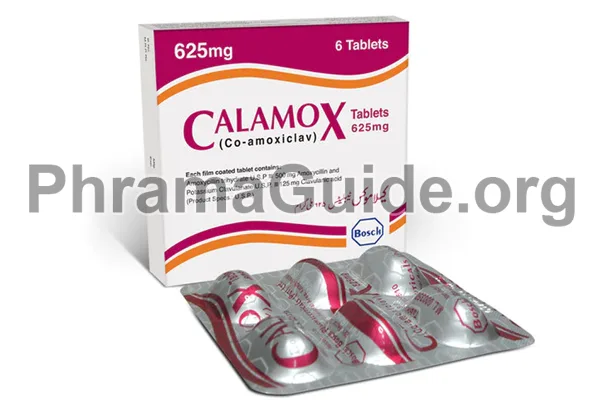Calamox tablet is used to treat a variety of bacterial infections. It is a broad-spectrum antibiotic that is often used as the first line of treatment for RTIs, UTIs, and other common infections. Following are some common and off-label uses of Calamox tablets:
Common Uses of Calamox Tablet
- Respiratory Tract Infections: Calamox tablets can be used to treat respiratory tract infections such as acute exacerbations of chronic bronchitis, pneumonia, and sinusitis.
- Urinary Tract Infections: Calamox tablet is an effective treatment against many bacteria that cause urinary tract infections such as cystitis, pyelonephritis, and prostatitis.
- Skin and Soft Tissue Infections: Calamox tablets can be used to treat skin and soft tissue infections such as cellulitis, infected bites, and infected wounds.
- Dental Infections: Calamox tablet is sometimes used to treat dental infections such as dental abscesses and periodontitis.
- Bone and Joint Infections: Calamox tablets can be used to treat bone and joint infections such as osteomyelitis and septic arthritis.
- Gynecological Infections: Calamox tablets can be used to treat gynecological infections such as pelvic inflammatory disease.
- Intra-Abdominal Infections: Calamox tablets can be used to treat intra-abdominal infections such as peritonitis and abscesses. Additionally, the uses of Calamox tablet is also an effective treatment for Helicobacter pylori infection associated with peptic ulcers or gastritis
- Sexually Transmitted Diseases: Calamox tablets can also be used to treat some sexually transmitted diseases, such as gonorrhea or chlamydia.
Off-label Uses of Calamox Tablet
- Community-Acquired Pneumonia (CAP): In some cases, Calamox tablets may be used off-label as an alternative or adjunctive treatment for community-acquired pneumonia caused by certain susceptible bacteria.
- Mastitis: In breastfeeding mothers with severe or persistent mastitis (breast infection), Calamox tablets may be used to treat the infection.
- Chronic Obstructive Pulmonary Disease (COPD) Exacerbations: Calamox tablets may be considered in cases of severe exacerbations of COPD associated with bacterial infections.
- Intra-Abdominal Infections: It may be used off-label for certain types of intra-abdominal infections, especially when caused by bacteria that are susceptible to amoxicillin/clavulanic acid.
- Prosthetic Joint Infections: Calamox tablets may be considered as part of a treatment regimen for prosthetic joint infections caused by susceptible bacteria.
- Skin and Soft Tissue Infections with MRSA: In some cases, Calamox tablet may be used as part of a broader treatment plan for skin and soft tissue infections when Methicillin-resistant Staphylococcus aureus (MRSA) is a suspected or confirmed pathogen.
- Empirical Treatment in Neutropenic Fever: In certain cases of neutropenic fever (fever in individuals with low white blood cell counts), Calamox tablets may be used as part of an empirical treatment regimen.
- Prevention of Surgical Site Infections: In specific surgical situations, Calamox tablets may be used prophylactically to prevent surgical site infections.

What is Calamox?
Calamox is one of the leading brands of Co-amoxiclav (amoxicillin and clavulanic acid), manufactured and marketed by Bosch Pharmaceuticals, Pakistan.
Calamox Alternatives : Other Similar Brands
The following are some alternative brands of Calamox and their manufacturers.
- Augmentin : GlaxoSmithKline (GSK).
- Amclav : Getz Pharmaceuticals Pakistan (Pvt) Ltd.
- Amoxi-Clav : Novartis Pharma (Pvt) Ltd.
- Co-Amoxi : Macter International (Pvt) Ltd.
- Fortecin : Searle Pakistan (Pvt) Ltd.
- Rite : Werrick Pharmaceuticals.
- Termibex : Highnoon Laboratories (Pvt) Ltd.
- Ultrex : Wilshire Laboratories (Pvt) Ltd.
- Zamovlav : Zafa Pharmaceutical Laboratories (Pvt) Ltd.
- Lavomox : Bloom Pharmaceuticals (Pvt) Ltd.
Calamox : Available Formulations and Strengths
Presently, Calamox is available in Tablet, Drops, Syrup, and Injection forms.
Calamox Tablets : 375mg, 625mg, and 1000mg (1g) strengths
Calamox Drops : 62.5mg/5ml strength
Calamox Syrup : 156.25mg/5ml, 312.5/5ml, and 457mg/5ml strengths
Calamox Injections : 0.3gm, 0.6gm, and 1.2gm strengths
Who Should Not Use Calamox?
It is important to understand the contraindications associated with the Calamox tablet.
- One of the primary contraindications for taking Calamox concerns its potential interactions with other medications. Calamox should not be taken in conjunction with other antibiotics or anticoagulants (blood thinners).
- Patients who have currently been prescribed methotrexate (a chemotherapy drug) should not take Calamox without first consulting their doctor.
- There may also be interactions between Calamox and drugs used to treat high blood pressure or heart disease.
- Patients who have kidney or liver problems are at increased risk for side effects when using this medication, they should only take it under close medical supervision if necessary.
- Patients who have had an allergic reaction or hypersensitivity reaction to any type of penicillin drug (including amoxicillin) in the past should not take Calamox without first speaking with a doctor about other options available for treating their condition safely and effectively.
- Pregnant women need to exercise caution when considering whether to take Calamox since its safety during pregnancy has not been established conclusively. Therefore, pregnant women are advised against using it unless approved by their doctor after carefully weighing out all possible risks and benefits associated with its use during pregnancy versus alternatives available for treating bacterial infection safely during pregnancy.
What is the Recommended Daily Dosage of Calamox?
Calamox Tablet Dose for Mild to Moderate Infections:
- One tablet of 375mg, three times a day for 7-10 days.
Calamox Dose for Severe Infections:
- One tablet of 625mg, three times a day for 7-10 days.
- Or 1 tablet of 1gm twice a day, depending on the severity.
Calamox Tablet Dose for Chronic UTI and Lower RTI
- 1 tablet of 1gm, two or three times a day, depending on the condition.
How Calamox Works?
Calamox contains two active ingredients: amoxicillin and clavulanic acid. Amoxicillin is a penicillin-type antibiotic that works by stopping the growth of bacteria, while clavulanic acid helps to prevent certain bacteria from becoming resistant to amoxicillin.

Leave A Comment